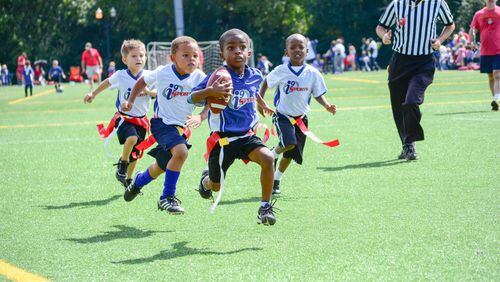SIGNS AND SYMPTOMS OF CONCUSSIONS
- Clumsy movement
- Behavior or personality change
- Sensitivity to light
- Increased sleeping
- Memory loss and confusion
Source: Marla Shapiro, chief neuropsychologist at Gwinnett Medical Center’s Concussion Institute
Imagine 600 youths aged 3 to 14 playing eight games of soccer and flag football at Gary Pirkle Park in Sugar Hill.
Now imagine them completing more than five hours of competition — no, an entire fall season — without injury.
Unthinkable?
“It can happen,” said Craig Magram, owner of the northwest Gwinnett and Hall county i9 Sports league. “We’re all about kids enjoying themselves, learning the fundamentals of sports without some of the dangerous risks that could lead to head injuries.”
As parental concerns about concussions mount, metro Atlanta athletic leagues like i9 Sports are stepping up their efforts to prevent such injuries.
“With all of the talk and repercussions of concussions and other injuries to children, we like i9 because it protects our kids,” said Alan Sweet, a Suwanee father of three. “This whole as I call it ‘kinder, gentler’ approach works across their entire program. Injuries are avoided and rules are developed to give every participant a good and balanced attempt to participate.
According to the Centers for Disease Control and Prevention, nearly half a million children visit the emergency room each year with a traumatic brain injury.
In an effort to help prevent brain injuries in youth athletes, i9 Sports recently launched Concussion Crusade, drawing up new rules like no heading and instituting a When In Doubt, Sit It Out policy that it hopes will make playing sports safer for children. In addition, all parents and young athletes must sign a pledge to practice good sportsmanship.
And the Northside Youth Organization, which has more than 6,000 children aged 4 to 14 in its programs, is also stepping up its game, said Jane Wilkins, executive director. With the heightened publicity about concussions, Wilkins said NYO has been even more diligent in its efforts.
“We’ve made a very concerted effort in all our sports to raise awareness,” Wilkins said.
That includes, she said, holding medical clinics for parents and athletes about how to avoid injury and what steps to take should injury occur.
“Children are not physically developed enough to absorb contact without serious risk of concussion, and the possibility of brain damage is very real,” said Dr. Robert Cantu, a renowned neurosurgeon, expert on youth sports safety and author of the book “Concussions and Our Kids.” “Youth sports have taken the wrong turn in that it’s all become so serious. People are grooming their children to be superstars, often without regard for their safety.”
Sweet initially enrolled his daughter and two sons, now ages 6, 8 and 10, in Magram’s league more for convenience than anything else.
“We like the no hard contact part,” Sweet said.
Before becoming a franchise owner seven years ago, Magram enrolled his son for the same reason Sweet did: convenience.
“The safety piece was right behind that,” he said. “It put the icing on the cake.”
When his family moved back to Georgia in September 2006, Magram said he decided “to take a leap of faith” and start his own business.
Some 300 kids enrolled the first season in 2007. That number more than tripled this past spring.
Robert Nycz of Sugar Hill said when he enrolled his sons, age 7 and 10, five years ago, he wasn’t aware of the concussion issue, but he likes the “no-contact policy.”
“Once your brain is damaged, it’s not easily repaired,” he said. “There can be lifelong problems.”
Because the signs and symptoms of concussions vary, it’s important parents know what to look for, said Marla Shapiro, chief neuropsychologist at Gwinnett Medical Center-Duluth’s Concussion Institute.
“The signs and symptoms can vary, and may not look all that different from ‘typical teenage variability,’” Shapiro said. “On one occasion, I saw a child whose first sign was that a slight tap on the head led to tears. Cognitive, physical, emotional, and sleep-related symptoms include headache, nausea, excessive fatigue, fogginess, sensitivity to light and/or noise, poorer memory, or just not feeling quite right.”
Shapiro said there is no magic formula or time frame because everyone recovers at their own rate, based on a variety of factors.
“What makes the impact of concussions so severe is if a second concussion occurs when the patient hasn’t healed from the first concussion,” she said.
“When they are symptom-free, we gradually return to physical activity, using a specific 5-7 step protocol under the supervision of a sports medicine professional with expertise in concussion management.”
Gov. Nathan Deal signed a bill recently, mandating how school coaches and recreation leaders should handle youth athletes who are suspected of having concussions.
Under the “Return to Play Act of 2013,” which goes into effect Jan. 1, any youth suspected of having a concussion must be removed from the game and cannot return to play until cleared by a health care professional.
Magram said i9 Sports considers protecting future generations from such injury its responsibility.
“Teachers educate them in school,” he said. “Parents teach them life lessons for survival. We want to protect their bodies while teaching them teamwork in a fun, safe and convenient environment.”
About the Author




/cloudfront-us-east-1.images.arcpublishing.com/ajc/P7DYBH6TO7FEKG4SUXQQKADRXE.jpg)


